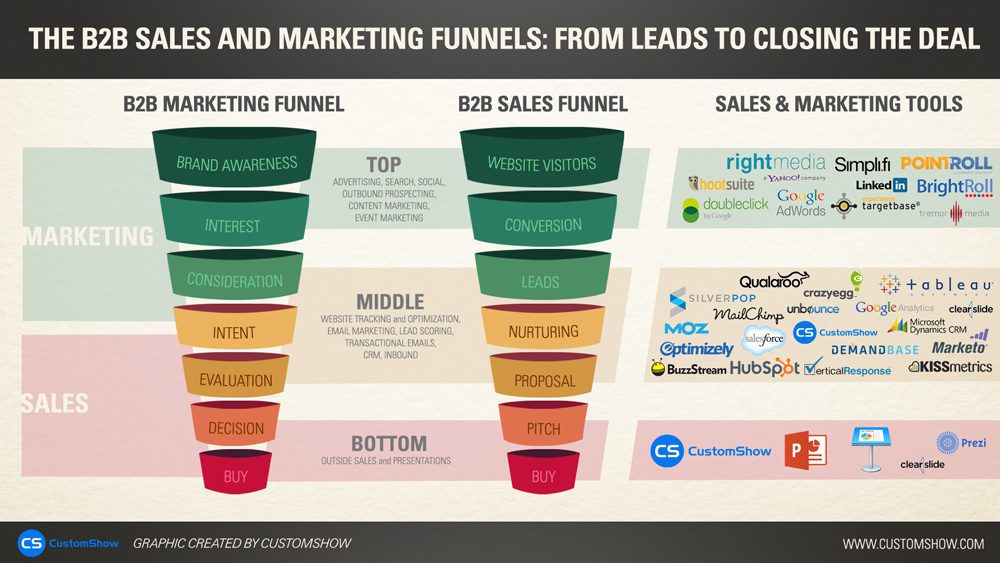In buying cycle vs sales process, the sales process is clear for most professionals. You perform your level of prospecting, initiate contact, assess the needs of the prospects, present your offer, schedule an appointment, and hopefully present and close the deal (plenty of steps in between those stages). But the remaining challenges for salespeople are more clearly understanding the buying cycle of their prospects and connecting with them at the right time. Even as I’m writing this, I received a cold call from someone who knew about my business and apparently knew me, but they simply caught me when I wasn’t interested in hearing the offer nor was it something I even cared for.
Some of the best ways for sales professionals to master the sales process is by understanding the channels in which to communicate with prospects and finally when’s the right time to establish contact. But first, we must understand the process for each cycle.
Sales Process:

- Prospect For Leads – information gathering which first begins with understanding the type of prospects you’re targeting and what channels you can leverage perform outreach through (i.e phone calls, email, LinkedIn, Twitter)
- Initiating Contact – At this stage, we have our standard script and trying to get to the decision-maker.
- Identify Needs – After making our way to the decision-maker, we’re first determining if there is a need for our product or service.
- Present Offer – At this junction, if there is a slight need, we’re presenting our offer.
- Schedule Appointment – After some persuasion and hopefully good education of the product/service, we’re scheduling an appointment.
- Presentation – At CustomShow, this is where we excel and believe more emphasis should be placed. By doubling conversions efforts at this stage, steps 1 – 5 before even more valuable.
- Close Sale – Any final loose ends required to close the sale.
Buying Cycle:

- Awareness: Steps you take to make people aware you exist and that there is a need.
- Research: After awareness is established, the person is now considering your product/service.
- Consideration/Comparison: They are now drilling down solutions to 3 – 5 options for purchase.
- Purchase: They are ready to make a purchase. They are informed and have the capital to move forward.
- Repurchase/Retention: They are re-evaluating their initial purchase and considering making another purchase.
Sales Process Activities For The Buying Cycle:
Most sales professionals will tell you sales at the discovery, consideration and purchase stages matter the most. It’s tough to sell to someone when they don’t even know they need the product or care for it. Specific activities at each stage can in fact improve sales performance:
- Awareness: At this stage, a salesperson should refrain from selling. Your job is to let your prospect know or at least see if they have a need that can impact their business be it a solution that increases revenues or decreases costs.
- Discovery: At this stage, the buyer may be currently in the market researching solutions. The question is are you in the right place so you’re being found and touching those individuals. That’s the purpose of advertising, but for salespeople, they’ll have a different and more aggressive selling approach if they know their prospect is that this stage of the funnel.
- Consideration: The buyer has nailed their options to 3 – 5 solutions that can fit their needs. Our job is to make sure we are within that consideration set.
- Purchase: Train has already left the station but you may be able to convince them to still consider your solution.
- Repurchase: Another great opportunity to have someone already invested in another product or service to consider you.
Salespeople work hard to understand where those buyers are in the purchase funnel or sales process. That level of understanding allows us to come up with the right questions, determine the right channels to communicate through, the proper verbiage, and even the right content to share with the prospect. In the weeks ahead, we will delve into these stages in-depth. However, considering the vertical, sales managers should contemplate focusing their salesforce solely on qualified leads instead of approaching individuals at the awareness stage. We hope the topic on buying cycle vs sales process is clear now.
Every good presentation is a good presentation builder that fit the intricacies and identity of your organization. At CustomShow, we believe our presentation software can do just that.

